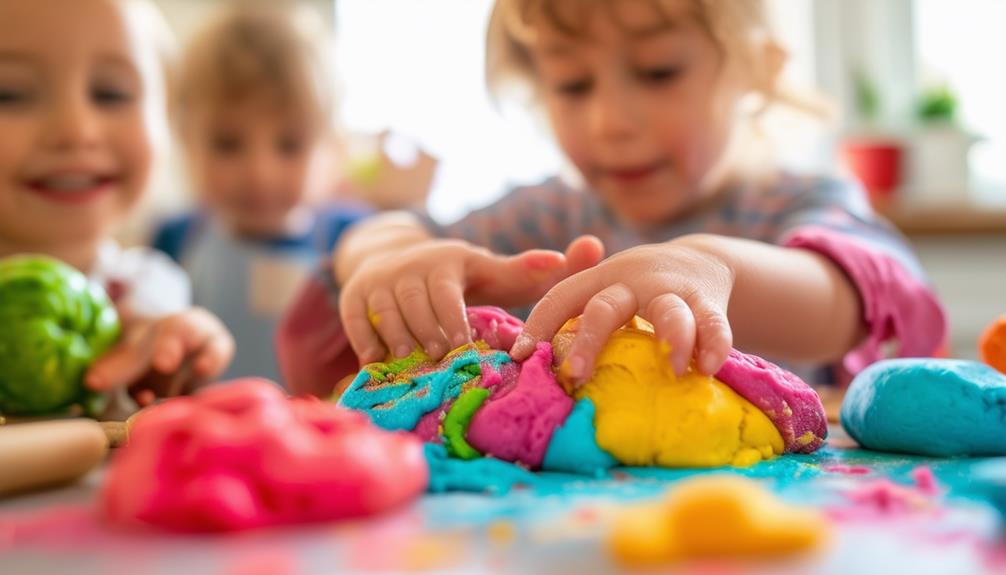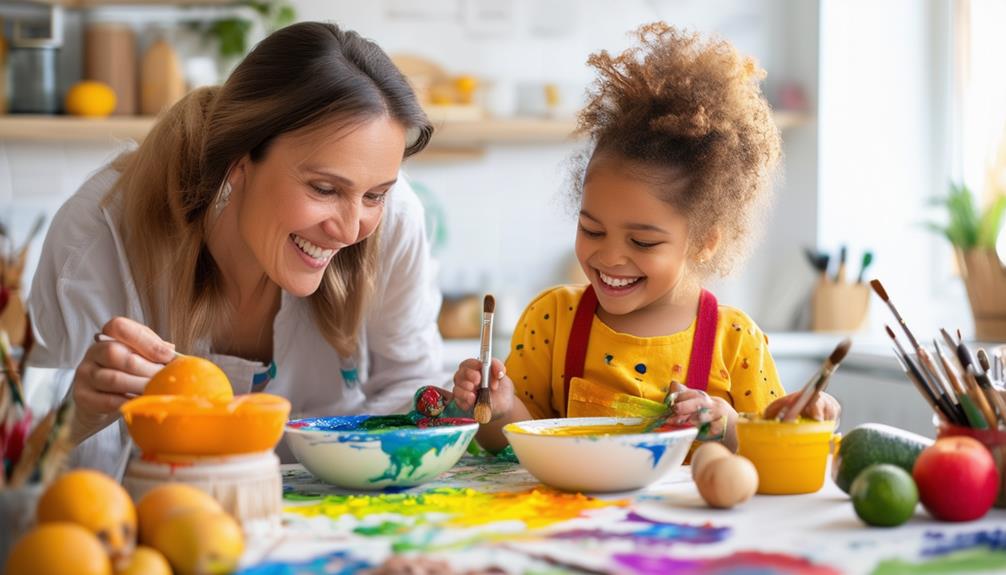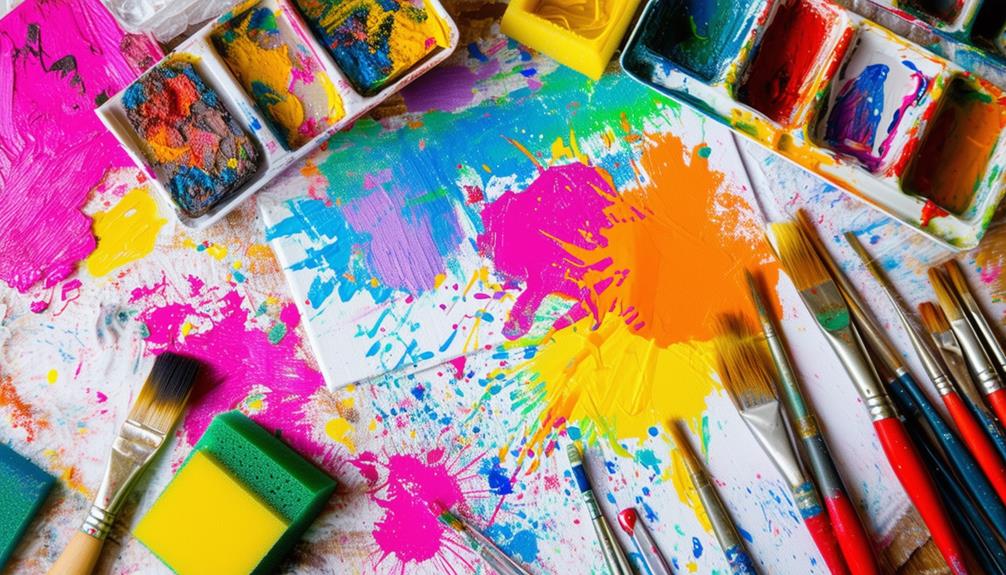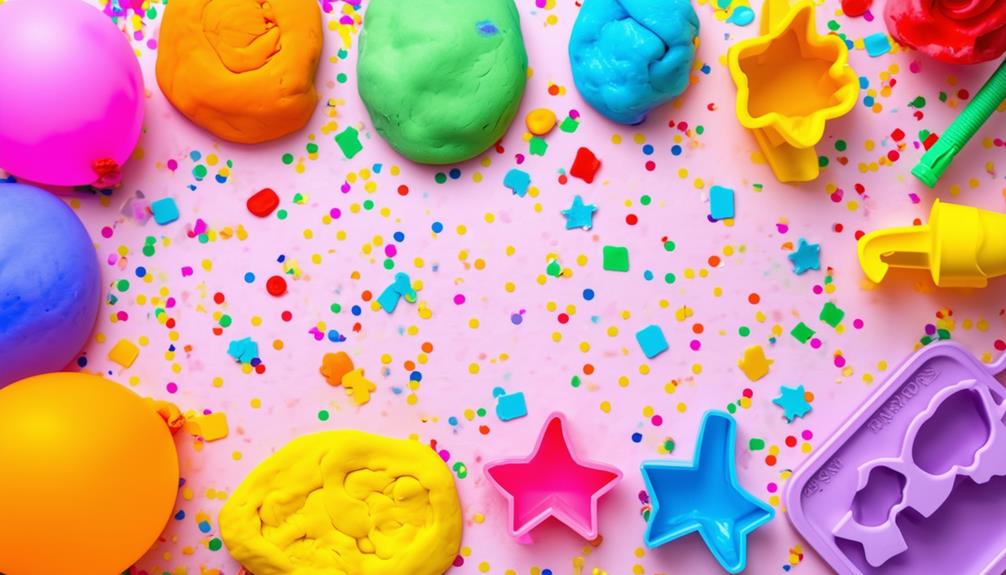How to Make Playdough With Only Two Ingredients

You might be surprised to learn that you can make playdough with just two common household ingredients: one cup of cornstarch and half a cup of hair conditioner. This combination yields a smooth, pliable dough perfect for kids' play. Achieving the ideal texture requires a bit of technique, and there's an easy trick to add vibrant colors. Want to know the exact steps and customization tips for endless fun? Let's break it down step-by-step.
Ingredients Needed
To make this easy playdough, you'll only need cornstarch and hair conditioner. This simple, homemade playdough recipe requires just two main ingredients, making it a quick and fun activity for kids. Start by measuring out one cup of cornstarch. Cornstarch provides the necessary texture, ensuring the playdough is firm enough to mold.
Next, measure half a cup of hair conditioner. This adds smoothness and flexibility, making it easy for kids to shape. You can also add food coloring to the conditioner for a more vibrant and sensory experience.
Mix the cornstarch and conditioner until you achieve the desired consistency. If the mixture is too dry, add more conditioner; if too sticky, add more cornstarch. With these simple steps, you can create homemade playdough perfect for hours of fun. This recipe's simplicity and versatility make it a fantastic DIY project that kids will love.
Mixing Instructions
Now that you've gathered your ingredients, let's move on to mixing them for the perfect playdough. Combine 2 cups of cornstarch and 1 cup of budget-friendly hair conditioner in a large bowl. This homemade recipe is quick and easy to prepare. Mix the cornstarch and conditioner using your hands until a smooth dough forms. If the dough feels too dry, add a bit more conditioner. If it feels too sticky, sprinkle in additional cornstarch.
This recipe is not suitable for making edible play dough due to the hair conditioner. However, it creates safe and fun homemade playdough. To add color, incorporate gel food coloring gradually, kneading it into the dough until you achieve the desired shade. This ensures vibrant, customized playdough without any mess. Once your playdough is ready, keep it covered when not in use to prevent drying out. Enjoy your crafting session with this simple and effective recipe!
Customizing Colors

To create vivid, personalized colors for your playdough, add a few drops of gel food coloring to each ball of dough. Start with 2-3 drops per ball for optimal color. Gel food coloring is preferred because it provides rich tones, making your playdough vibrant. However, be aware that it can stain your hands. To achieve an even color, knead the dough thoroughly. The more you knead, the more uniform the color will become. For a more adventurous approach, try mixing different dyes to create a variety of colors. This not only customizes your playdough but also enhances the sensory play experience for children.
Here's a quick guide for mixing colors:
| Base Color | Added Dye | Resulting Color |
|---|---|---|
| Red | Yellow | Orange |
| Blue | Red | Purple |
| Yellow | Blue | Green |
Storing the Playdough
After customizing your playdough's color, it's crucial to store it properly to keep it fresh and pliable. Always use an airtight container for homemade playdough to prevent drying out and maintain its freshness. Proper storage ensures your playdough remains soft and usable for longer periods.
Avoid exposing the playdough to air for extended periods, as this will cause it to dry out. It's also important to keep the playdough away from direct sunlight and heat sources. Exposure to sunlight can cause the playdough to either melt or harden, which ruins its texture. Therefore, store it in a cool, dark place to prevent these issues.
Label the containers with the date you made the playdough to track its freshness and know when to make a new batch. Proper storage involves not just using a container, but also ensuring that the storage conditions are ideal. By following these steps, you'll keep your homemade playdough in optimal condition, ready for hours of creative play. Store your playdough correctly, and it will remain perfect for playtime!
Benefits for Children

Playing with playdough offers numerous developmental benefits for children, making it an excellent activity for fostering growth and learning. When you use simple recipes to create homemade playdough, you provide a fun sensory experience that helps children develop fine motor skills. Activities like squeezing, rolling, and shaping the dough strengthen their small muscles and improve dexterity.
Additionally, playdough encourages imaginative play and creativity. Kids can explore different shapes and textures, coming up with unique creations that stimulate their minds. These activities are not only fun but also educational, helping children learn colors, shapes, and other fundamental concepts through hands-on engagement.
The sensory experiences provided by playdough, especially when using scented versions, can be incredibly engaging for children. They use their senses of touch, smell, and sight, creating a multi-sensory environment that enriches playtime.
Furthermore, playing with playdough can enhance social skills. When children collaborate on projects, share tools, and take turns, they learn essential social interactions. Homemade playdough is thus a versatile tool for both individual and group play, fostering a range of developmental benefits.
Fun Activities
Discover endless creative play ideas with homemade playdough, from crafting animals to building miniature worlds. Sensory experimentation enhances your child's tactile experiences as they mold and shape the dough. It's a fun and educational way to boost creativity and fine motor skills.
Creative Play Ideas
Transform playdough time into an engaging and educational experience with printable, laminated mats. These mats can be paired with your favorite playdough recipes to create structured activities that foster both fun and learning. Themed play dough mats encourage artistic expression and imaginative play as children shape and mold their creations.
Printable play dough mats support the development of fine motor skills, improving dexterity as kids press, roll, and shape the dough. Laminating these mats enhances their durability, ensuring they withstand multiple uses and maintain their educational value.
Structured play dough activities with these mats allow children to explore different themes, from animals to numbers, enhancing sensory exploration and learning. These activities can be tailored to various developmental stages, making them versatile tools in any playroom. By using these creative play ideas, you'll provide endless opportunities for children to learn, grow, and have fun all at once.
Sensory Exploration Benefits
Exploring the sensory benefits of playdough transforms everyday play into a rich developmental experience for children. Sensory play with playdough engages touch, sight, and smell, promoting overall development. As children mold, squish, and shape the playdough, they enhance fine motor skills and hand-eye coordination, crucial for tasks like writing and buttoning clothes.
Imaginative play with playdough fosters creativity, problem-solving, and cognitive development. Children can create different scenarios and characters, enhancing their ability to think outside the box. Adding scents like aromatherapy oils or herbs can enrich the sensory experience, creating a calming atmosphere for winding down or an invigorating aroma for energizing playtime.
Incorporating textured materials like glitter or sand provides extra sensory stimulation and tactile exploration, making playdough more engaging. These diverse textures and scents create a multisensory experience that is both enjoyable and educational. By integrating these elements into playdough activities, you offer holistic sensory stimulation that supports your child's growth and development delightfully.




